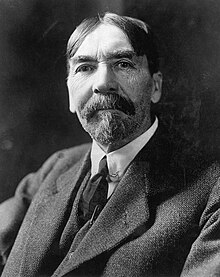Validity consumption
Conspicuous consumption is a 1899 by Thorstein Veblen introduced and on his " Theory of the Leisure " ( The Theory Of The Leisure Class ) declining sociological term for striking at public impact (d. H. On application ) target forming, goods (ver) consumption forming action ( conspicuous consumption ).
As “ demonstrative consumption ” or “ demonstrative waste ”, public consumption aims to show what one can afford (to flaunt, brag, flaunt); this is intended to represent or increase the social status . It can therefore be viewed as a form of imposing behavior through status symbols .
Historically and archaeologically, validity consumption can be ascertained back into early history, whereby magnificent burials with rich grave goods in particular are often (also) explained in this way today: by, for example, giving a pharaoh the symbols of his wealth in the grave, according to this perspective, one documented less a belief in the hereafter than the wealth of the ruling family, because during the funeral everyone could see the enormous values that were simply sunk into the earth.
In Europe, the consumption of validity was particularly pronounced in the Roman upper class and the baroque monarchies . Only in light of the then prevailing civic and especially Puritan , seen on simplicity counterculture ( soli deo gloria ) he was particularly the vicious , later called " nouveau riche attributed".
Behind the demonstrative consumption there is usually a value system that assumes that one's own social prestige depends above all on the material standard of living .
By contrast, in other social contexts (e.g. often among intellectuals , in the alternative movement or in so-called bohemian circles ) other values are considered relevant to one's own reputation . B. Education , creativity or the individual life plan ( post-materialism ).
Historical development of validity consumption
Veblen does focus in his study on the special aspects of the consumption of validity in modern societies, but sees this already in “predatory cultures”. These are distinguished by an upper class of physically superior men, among whom the unproductive consumption of various foods and drinks, including alcohol and narcotics, are considered honorable. In earlier stages of culture, the ailments caused by consumption also express a high status. In these cultures, women are like slaves. They are barred from wasteful consumption, they are only allowed to consume what they need to continue their work, although they produce the goods that men need for demonstrative consumption. An exception is the case in which a woman's consumption brings her master comfort or prestige. The same applies to lower social classes, who are also only allowed to consume what they need to work. Since the production of luxury goods is not yet particularly pronounced, wasting time and effort, i.e. showing leisure, is of particular importance. The offices that have to do with the field of activity of the upper classes in the broadest sense, such as fighting, hunting or the maintenance of war equipment, are considered noble.
The transition to a more peaceful cultural stage is marked by the increasing spread of private property, paid work and smaller housekeeping. Ongoing social change is making class boundaries disappear more and more, the abolition of slavery and serfdom dwindles the importance of demonstrative leisure, at the same time work loses its shameful character and is upgraded. An aversion to any waste and senselessness develops. These paradoxical requirements are solved by always disguising demonstrative leisure as productive and useful. Veblen includes various activities of women in the middle class household or newly created social duties, such as the founding of charities by American millionaires, for whom the fight against grievances is only a pretext for the consumption of status. As the means of communication become more efficient in modern societies and mobility increases, the demonstrative waste of goods is gaining in importance. To be effective, an individual's financial strength needs to be written on their forehead as much as possible. Due to the higher mobility and the resulting increased attractiveness of consumption, Veblen explains that the average income in the city is higher than in the country, but the city dwellers live more from hand to mouth than rural dwellers.
Conceptual field
There are a variety of largely the same significant terms that are listed separately here because of their scope: date of application consumption , representation consumption , conspicuous consumption , conspicuous consumption , ostentatious consumption , Prestige effect , Veblen good or French. consommation ostentatoire . The snob effect emphasizes the uniqueness of the good consumed.
Economics
The bubble effect explains why the demand for goods can also increase if their price rises (and does not fall as expected).
This claims that consumers consume a good precisely because of its high price. That is, a certain good is not considered exclusive enough because of its low price.
See also
literature
- Thorstein Veblen: Theory of the Fine People. An economic study of institutions , Fischer Verlag, 1997, ISBN 9783596273621
Web links
Individual evidence
- ↑ Sighard Neckel : Sternstunden der Soziologie , p. 429 f.
- ^ Sighard Neckel: Sternstunden der Soziologie , p. 432 f.
- ↑ Sighard Neckel: Sternstunden der Soziologie , p. 439 f.
- ↑ cf. Walter Theiler, Fundamentals of Economics: Microeconomics, p. 144
